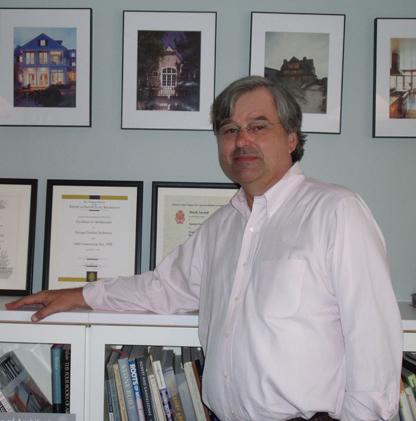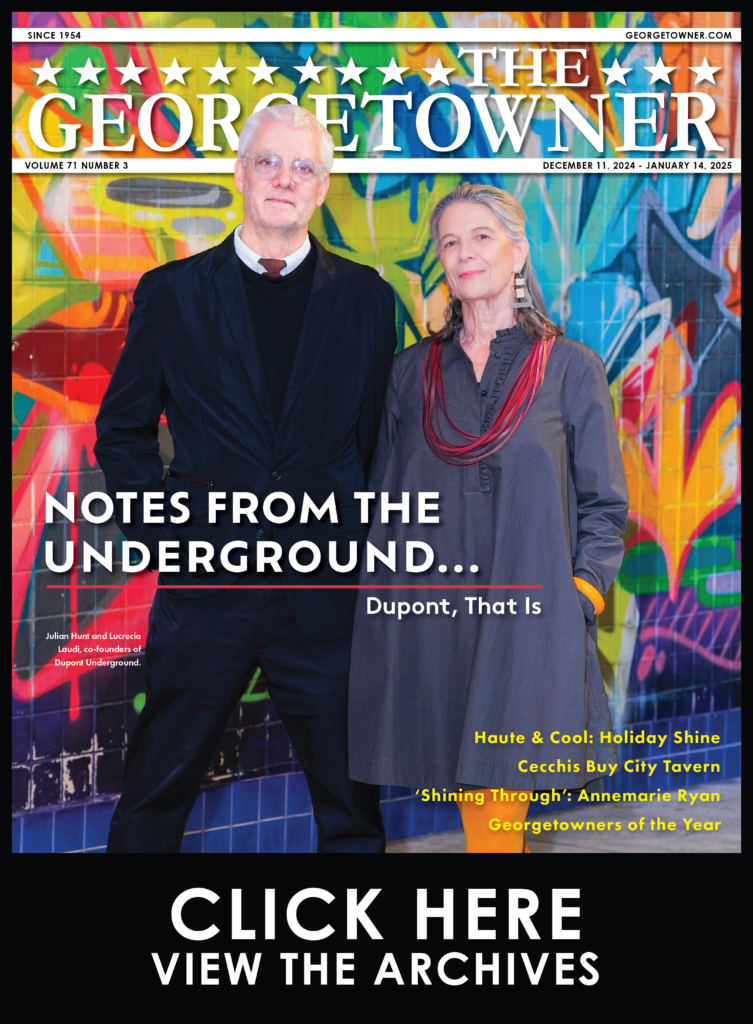Meet the man behind several of Georgetown’s signature structures, including Patisserie Poupon, Bo Concepts and Patagonia. John Blee sits down for a chat with George Gordon, one of the neighborhood’s most prominent architects.
When you work with a client, how do you merge with their aesthetic? Or do you try to shift their taste in your direction?
We begin by listening to the client’s needs and vision for the project and interpreting them into a built form. For example, we recently worked with a restaurateur who wanted a sign and awning but on meeting him, we observed that the interior of the restaurant used a good bit of stainless steel. We designed a metal “awning” (instead of the fabric type normally seen) with a stylized sign of his logo in stainless steel. Although pricy, the client was thrilled with the concept and is eager to have the awning installed, extending the theme of his restaurant out over the sidewalk.
In designing a house what do you enjoy the most? What do you have to struggle with other than financial constraints?
In working with a client on a house or other owner/user residential spaces (apartments, etc.) what’s most satisfying — and actually most challenging too — is conceptualizing a design that envelopes the client’s lifestyle and image. It is easy to get a quick impression of how a person lives and what seems important to them, but in working with clients, the true concerns eventually emerge. Clients who have portrayed themselves as very traditional have been revealed to really dislike clutter, and in the design process gravitate toward a cleaner, more streamlined design. Clients who at first meeting almost demanded such finishes as granite countertops have reconsidered when a warmer, more welcoming palette of materials is presented to them. Summing up, it is a challenge to know when to listen and when to prod.
Where did you study, and who has influenced you as an architect?
I went to school at Rensselaer Polytechnic Institute and received a rigorous, though a bit technical, education. The people who have had a great influence on me as an architect are the architects who I worked for when I started my career. All architects admire the greats. Architects such at Le Corbusier, Lutyens and Kahn. But the greatest impact was from working with very talented architects and observing how they worked their “majic.”
Do you do interiors, including placement of furniture, and if so, is that more complex in terms of client preference?
Not usually. We do measure a client’s furniture and show furniture placement on the drawings to give a sense of room size and layout. But actual placement not as often.
Is the contractor someone you carry over from job to job?
We do have a preferred group of contractors, and view recommending general contractors to clients as kin to marriage brokering. One contractor’s operation may be better suited to a client’s personality and preferred way of doing things than another. We try to make that pairing.
What’s your fastest turn-around for designing a house from scratch, from drawings to the client moving in?
Probably about a year. There are many decisions to be made and clients often want a bit of time to consider all the choices. After all, they are going to live among the decisions for a long time, so better to do the best at first pass.
Do you do kitchens, and if so, what’s the most expensive job you’ve done and what did it include?
We do kitchens, usually in conjunction with another program component, such as a family room or outdoor space. The most involved kitchens have included professional equipment, specialty appliances (such as a custom-made French range) and specific equipment for specific tasks: pizza oven, etc.
How do you work with light in your houses, how is that achieved?
We like to be involved in the design and fixture selection of lighting systems. There is a good bit of new technology, such as scene controls, that will allow the client to further customize their living experience and adapt the feel of spaces to various situations, family living, Sunday brunch, elegant dinner party. The selection of fixtures from a performance point of view and energy consumption is very important. And what makes the space come to life more dazzlingly than really nice lighting?
What is the house you’ve worked on that you are most proud of?
A waterfront house in Annapolis. It is a very quirky design, very tailored for the client and the setting. For example, there is a roof dormer in the master bedroom that exactly frames a view of the [State House] dome. The framing of views, connection to the water and the play of the spaces, interior to exterior, has produced a sequential experience that must be seen. Photographs do not adequately capture the progressing through the house from front door to pier on the water.
Name the five best buildings in the D.C. area you did not design.
The Institute for International Economics on Massachusetts Avenue, the lobby of 1999 K St., the Christian Science Center on 16th Street, the Gannett Complex in McLean, and the National Association of Realtors building on New Jersey Avenue.
Other than your own, what house in D.C. would you most like to live in?
The Marcel Breuer house in northwest D.C.


